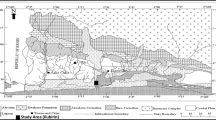Abstract
Orthogonal set of 2D geoelectrical resistivity field data, consisting of six parallel and five perpendicular profiles, were collected in an investigation site using the conventional Wenner array. Seven Schlumberger soundings were also conducted on the site to provide ID layering information and supplement the orthogonal 2D profiles. The observed 2D apparent resistivity data were first processed individually and then collated into 3D data set which was processed using a 3D inversion code. The 3D model resistivity images obtained from the inversion are presented as horizontal depth slices. Some distortions observed in the 2D images from the inversion of the 2D profiles are not observed in the 2D images extracted from the 3D inversion. The survey was conducted with the aim of investigating the degree of weathering and fracturing in the weathered profile, and thereby ascertaining the suitability of the site for engineering constructions as well as determining its groundwater potential.









Similar content being viewed by others
References
Acworth RI (1987) The development of crystalline basement aquifer in a tropical Environment. Q J Eng Geol 20:265–272
Adepelumi AA, Ako BD, Ajayi TR (2001) Groundwater contamination in the basement-complex area of Ile–Ife, southwestern Nigeria: a case study using electrical resistivity method. Hydrogeol J 9:611–622
Akintola JO (1986) Rainfall distribution in Nigeria, 1892–1983. Impact Publishers, Ibadan
Amidu SA, Olayinka AI (2006) Environmental assessment of sewage disposal systems using 2D electrical resistivity imaging and geochemical analysis: a case study from Ibadan, southwestern Nigeria. Environ Eng Geosci 7(3):261–272
Dahlin T, Loke MH (1998) Resolution of 2D Wenner resistivity imaging as assessed by numerical modelling. J Appl Geophys 38(4):237–248
de Groot-Hedlin C, Constable SC (1990) Occam’s inversion to generate smooth two-dimensional models from magnetotelluric data. Geophysics 55:1613–1624
Griffiths DH, Barker RD (1993) Two dimensional resistivity imaging and modeling in areas of complex geology. J Appl Geophys 29:211–226
Griffiths DH, Turnbull J, Olayinka AI (1990) Two-dimensional resistivity mapping with a complex controlled array. First Break 8(4):121–129
Li Y, Oldenburg DW (1994) Inversion of 3D DC resistivity data using an approximate inverse mapping. Geophys J Int 116:527–537
Loke MH, Barker RD (1996a) Rapid least-squares inversion of apparent resistivity pseudosections by a quasi-Newton method. Geophys Prospect 44:131–152
Loke MH, Barker RD (1996b) Practical techniques for 3D resistivity surveys and data inversion. Geophys Prospect 44:499–524
Loke MH (2001) Electrical imaging surveys for environmental and engineering studies: a practical guide to 2D and 3D surveys, 62 pp. Available at http://www.geoelectrical.com
Olayinka AI (1999) Advantage of two-dimensional geoelectrical imaging for groundwater prospecting: case study from Ira, southwestern Nigeria. J NAH 10:55–61
Olayinka AI, Yaramanci U (1999) Choice of the best model in 2-D geoelectrical imaging: case study from a waste dump site. Eur J Environ Eng Geophys 3:221–244
Sasaki Y (1992) Resolution of resistivity tomography inferred from numerical simulation. Geophys Prospect 40:453–464
White RMS, Collins S, Denne R, Hee R, Brown P (2001) A new survey design for 3D IP modelling at Copper hill. Explor Geophys 32:152–155
Zhou QY, Shimada J, Sata A (2001) Three-dimensional spatial and temporal monitoring of soil water content using electrical tomography. Water Resour Res 37(2):273–285
Acknowledgments
The Third World Academy of Science (TWAS), Italy, in collaboration with the Council of Scientific and Industrial Research (CSIR), India, are gratefully acknowledged for providing the Fellowship for this study at the National Geophysical Research Institute (NGRI), Hyderabad, India.
Author information
Authors and Affiliations
Corresponding author
Rights and permissions
About this article
Cite this article
Aizebeokhai, A.P., Olayinka, A.I. & Singh, V.S. Application of 2D and 3D geoelectrical resistivity imaging for engineering site investigation in a crystalline basement terrain, southwestern Nigeria. Environ Earth Sci 61, 1481–1492 (2010). https://doi.org/10.1007/s12665-010-0464-z
Received:
Accepted:
Published:
Issue Date:
DOI: https://doi.org/10.1007/s12665-010-0464-z




